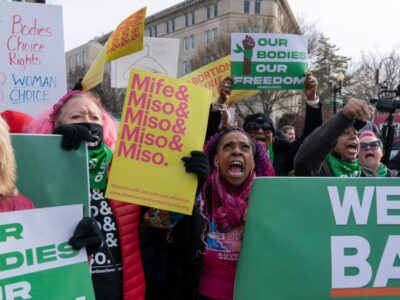
In overturning Roe v. Wade, the US Supreme Court gave state-level judges enormous new power to decide the reproductive fates of tens of millions of people of childbearing age. With the national right to abortion wiped out, states were forced to decide if abortions were legal for their residents as pre-Roe “zombie” laws, trigger bans, and state constitutional protections whipsawed pregnant people trying to receive care. And now, in ten states, abortion-rights ballot measures are going before voters.
It has been up to state courts to sort out this increasingly convoluted mess. Could a 150-year-old law criminalizing abortion be used to prosecute modern-day doctors? The Arizona Supreme Court decided it could. Do frozen embryos count as “children”? The Alabama Supreme Court said so in February. And does a state constitution’s guarantee of “life, liberty, and the pursuit of happiness” protect a woman’s right to end her own pregnancy? Last month, a North Dakota state judge decided yes. Meanwhile, over the last year, state supreme courts in Iowa, Florida, and Georgia have all allowed six-week bans on abortion to take effect.
Yet unlike their federal counterparts, these black-robed figures don’t enjoy lifetime appointments. Two years after Dobbs, state supreme courts have become among the most critical battlegrounds of the 2024 elections. Twenty-two states allow voters to elect their state supreme court justices, and several more let voters decide whether to retain justices appointed by the governor. Anti-abortion forces have long understood that controlling who sits on state high courts is critical to cementing and expanding their far-right agenda. Indeed, it was only after the GOP governors of Iowa and Florida packed their supreme courts with conservative justices did those courts overturn prior state precedents and uphold draconian abortion bans.
“State courts have been an under-resourced and overlooked tool for reproductive and gender equity.”
Abortion rights supporters are finally seeing the light. “State courts have been an under-resourced and overlooked tool for reproductive and gender equity,” says Cristina Uribe, director of the Gender Equity Action Fund, which channels money to local progressive and reproductive-rights advocacy groups that educate voters about state-level judicial races. “There’s a lot of opportunity here, and a lot of work left to do to make sure people understand the power that state courts have over their daily lives and the power they have to decide who sits on the bench.”
Progressives made the most of that opportunity in last year’s Wisconsin Supreme Court special election, which shattered turnout and spending records in a battle for ideological control of the highest court in a crucial swing state. The victory of an openly pro-choice justice, Janet Protasiewicz, swung control of the court leftward for the first time in 15 years, with consequences for both abortion access and voter rights. The court has the final say over Wisconsin’s congressional maps, for instance, which have been heavily gerrymandered to favor the GOP.
Advocates like Uribe are hoping that concerns over reproductive rights will have the same impact this November. “Abortion turns out to be really highly mobilizing,” she says. (It’s true.) “I do believe voters subconsciously associate the US Supreme Court with ‘they created this mess.’ They don’t want the state court creating more of a mess.”
So which states have supreme court elections to watch? Here are seven states where the outcome on November 5 could influence the future of abortion rights for tens of millions of people.
Ohio
A trio of partisan Supreme Court races are expected to shape how Ohio implements an abortion-rights amendment that passed with broad support last year.
In November 2023, Ohioans voted overwhelmingly to create a state constitutional right to “make and carry out one’s own reproductive decisions.” But what does that mean for the state’s six-week abortion ban, which is still on the books? What about the many other incremental restrictions on abortion that lawmakers have passed over the decades? As long as the Republican-dominated state legislature doesn’t repeal these laws—and they haven’t—it’s up to the courts to decide.
So far, in response to lawsuits by abortion-rights advocates, lower-court Ohio judges have permanently blocked the six-week ban and have temporarily blocked a 24-hour waiting period and a rule against physician assistants and nurse practitioners providing abortion pills. But those fights aren’t over—and they will almost certainly be appealed all the way up to the state’s high court, which is now controlled 4-3 by Republican justices.
Ohio Supreme Court terms last six years, and races were nonpartisan until 2021, when GOP state lawmakers voted to add candidates’ party affiliations to the ballot, claiming it was needed to better inform voters (they had just lost three seats to liberal candidates.) This year’s races are uphill battles for Democrats, who need to win all three state seats to gain a majority and potentially determine the outcome of the abortion rights cases. If Republicans win all three, they’ll hold a 6-1 supermajority, with a clear advantage for abortion opponents.
Michigan
As in Ohio, Michigan’s Supreme Court has the final word on whether old anti-abortion laws will be overturned after voters passed a constitutional amendment enshrining abortion rights in 2022. Democratic Gov. Gretchen Whitmer has already signed a package of bills repealing some laws that conflicted with the new amendment. But other restrictions persist, including a ban on Medicaid-funded abortions and a parental consent requirement for minors.
Michigan justices serve eight-year terms, with two seats up for election at a time, and no term limits. Democratic-backed justices currently hold a 4-3 majority on the court, and Republican-backed candidates will need to win both races on the November ballot to flip control. (While Michigan Supreme Court races are ostensibly nonpartisan, candidates are selected at party nominating conventions.) Justice Kyra Harris Bolden, an incumbent appointed by Whitmer, is running against Judge Patrick O’Grady, who was nominated after a Trump ally charged with election tampering dropped out. Meanwhile, law professor Kimberly Thomas is the Democrat vying for an open seat against Republican state representative Andrew Fink. In 2021, Fink supported a city ordinance making it a crime to “aid or abet” abortion in the Ohio city of Hillsdale, the home of an influential conservative Christian college.
Montana
In a red state where voters put a premium on keeping the government out of people’s daily lives, the Montana Supreme Court has often taken a remarkably permissive approach to abortion rights. In a 1999 case, Armstrong v. State, it ruled that the state constitution’s strong language around privacy implies a right to “procreative autonomy.” Based on this precedent, even before Dobbs, state courts struck down a parade of anti-abortion laws:: a 20-week ban, waiting periods, mandatory ultrasounds, parental notification requirements, and prohibition of telemedicine abortion, among others.
But with two of the seven state Supreme Court seats up for grabs this November, reproductive rights advocates are worried the tide could shift, especially with the state attorney general firing shots at Armstrong. Justices serve eight-year terms, and the court is officially nonpartisan, but both retiring justices are seen as left-leaning. Two candidates to replace them, Jerry Lynch and Katherine Bidegaray, have both said they agreed with Armstrong’s reasoning (responding to a Montana ACLU questionnaire). Two others, Cory Swanson and Dan Wilson, have been dubbed part of a “pro-life team for Montana” by the anti-abortion group Susan B. Anthony Pro-Life America—and neither answered the ACLU question.
One additional factor: If Montana voters pass a constitutional amendment known as CI-128 that’s also on the November ballot, they’ll enshrine an explicit right to abortion until the point of fetal viability, around 24 weeks. As in Ohio and Michigan, it will be up to the state Supreme Court to interpret the amendment, if it passes.
North Carolina
Over the past few years, conservatives have gradually flipped control of North Carolina’s supreme court, and Republican justices now hold a 5-2 majority. They could extend that margin to 6-1 this year if state Court of Appeals Judge Jefferson Griffin beats incumbent Justice Allison Riggs, who was appointed by Democratic Gov. Roy Cooper to fill a vacancy.
Griffin is seen as a threat to abortion rights. Last year, he was part of a three-judge panel that ruled that a mother’s parental rights could be terminated if her child was in utero at the time she committed a crime—because “life begins at conception.” The ruling was so error-ridden, and the outcry so loud, that it was withdrawn three weeks later.
Now, Griffin could ascend to the state’s highest court for an eight-year term. But even if Riggs keeps her seat, Democrats would need to win Supreme Court races again in 2026 and 2028 to recover the majority. It’s a long game in a state that once served as an abortion-access lifeline to pregnant people in the South— until a single state representative switched parties and gave Republicans the supermajority they needed to enact a 12-week abortion ban over Cooper’s veto last year.
Retention elections in Arizona and Indiana
In Arizona and Indiana, supreme court justices are appointed by governors but must run for a retention election after two years, and then every six or ten years thereafter. (In Arizona, for instance, an initial 2-year term would be followed followed by 6-year terms. Indiana’s initial 2-year term is then followed by a 10- year term.) Usually, these up-or-down votes in the retention election are perfunctory: Only six judges in Arizona’s 112-year history have not been retained, according to the Tucson Sentinel, and it’s never happened at the supreme court level.
Voters this year could buck that trend, as progressive and abortion-rights advocates try to mobilize a “No” vote on retention elections for Justices Clint Bolick and Kathryn King in Arizona; and Justices Mark Massa, Derek Molter, and Loretta Rush in Indiana.
All these justices have signed on to opinions that blocked access to abortion in their states. In Arizona, Bolick and King joined a ruling in April that said the state could enforce its 1864 “zombie” abortion ban—triggering so much public outcry, the legislature soon repealed the old law. In Indiana, the three justices upheld a near-total abortion ban, interpreting the state constitution to only protect abortion when the procedure was “necessary to protect [the pregnant person’s] life or to protect her from a serious health risk.”
While retention elections have been sleepy in the past, the campaigns against these justices have made some sit up and take notice. Supporters of the Arizona judges are trying to stop the judicial elections altogether, by filing their own ballot initiative. Proposition 137 would eliminate the state’s retention election system, and instead allow appointed judges to keep their seats indefinitely unless they are convicted of a crime or a commission finds their performance lacking. If it passes, it would nullify “No” votes against King or Bolick.
Texas
The Texas Supreme Court has been uniformly Republican since 1998. So it seemed like a safe bet that the three incumbent Republican justices—Jimmy Blacklock, John Devine, and Jane Bland—would easily swat away their trio of Democratic challengers this November. That was until the emergence of Find Out PAC—a committee formed this spring by former US Air Force undersecretary Gina Ortiz Jones to go after the Texas justices who “f*cked around with our reproductive freedoms, and now they’re going to find out,” as the group’s website puts it.
Find Out PAC’s ads draw attention to the justices’ recent rulings against women who were denied abortions amid dangerous pregnancies. Last December, the court ruled against Kate Cox, a pregnant woman who found out her fetus had no chance of survival. Her doctor said carrying the pregnancy to term would put her at high risk for serious medical complications and require her to undergo a C-section, so Cox sought to temporarily block the state’s ban so she could get an abortion. A lower court initially agreed, but the Texas Supreme Court stepped in to block the order. Then, in May, the court unanimously decided that the state abortion ban’s medical exceptions were sufficiently clear, even though a group of women said they were denied abortions despite experiencing serious pregnancy complications. One of the plaintiffs, Amanda Zurawski, had been forced to wait until she was diagnosed with a life-threatening case of sepsis and a fallopian tube infection that affected her future fertility.
The odds are still long in all three races, but the seat considered most likely to flip is currently held by Justice John Devine, who has bragged about being arrested outside abortion clinics; he also missed more than half of oral arguments between last September and February because he was too busy campaigning. “These folks are elected; they can be unelected,” Jones told the Austin-American Statesman. “Republicans understand that the bench is a stepping stone for higher office, while we’re not even fighting for those seats.”















